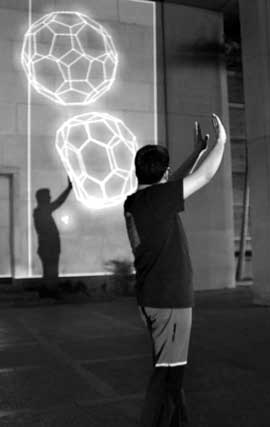|
|
|
| New Wave Art and science unite in a unique presentation designed to explain nanotechnology
DAILY BRUIN STAFF spuri@media.ucla.edu From those colorful little textbook diagrams that elucidate complex subjects to abstract paintings that can describe scenes that words cannot, art is a tool that helps us understand our world. And if a picture really can paint a thousand words then a billion can be said tonight with an interactive demonstration like "Zero@wavefunction: nano dreams and nightmares" where the aesthetic meets the atom in the Court of Sciences. Narrowing the gap between the concrete rationality of science and the fluid creativity of art, this presentation aims to bring the art of nanoscience to a more general public. UCLA, the home to California NanoSystems Institute, has been at the helm of this brave new world of science. The prefix "nano" means "one-billionth," and nanoscience studies materials with very small dimensions as a way of understanding the world at large. Yet to most people, this new wave of science and technology remains an enigma. For this reason "Zero@wavefunction" uses art as a didactic tool providing people with a better comprehension. In turn, nanoscience will help give a new perspective on art. UCLA's Department of Design | Media Arts chairwoman Victoria Vesna and professor of chemistry and biochemistry James Gimzewski created this collaboration. The presentation couples various technological advances and artistic styling to mold a world where art meets science. "We wanted to make a presentation that showed people art and science were not two completely separate disciplines, but rather that they can intertwine and can influence and affect each other," Vesna said. The presentation is divided into three separate projects. The first, titled "Projections," is founded on the idea that all forms of matter change shape. In this installation, a super-sized shadow of the participant is cast on the wall of Young Hall. This shadow activates software nanomolecules (buckyballs), and with the help of sensors, the molecule changes shape and direction in response to the person's movements. "The first project is definitely a playful act that draws people in," Vesna said. "It's a very experiential presentation that someone would understand more from experiencing it and playing with it." The second and third projects are aimed at providing a more solid definition of the expansive term "nanoscience." The second project combines short quotes and headlines into a collection describing various key points of nanoscience. The third project, "Windows to Nanotech," includes Gimzewski's Web cams that he has set-up in his office to provide access to a larger audience. "After reading about nanoscience you can see how the nuances of art can be seen in a physics experiment and how these two subjects become so interwoven and interrelated," said Vikas Erraballi, a first-year neuroscience student. The presentation will be a two-part production. Scientists will discuss how they produce such sensitive technology as the buckyballs and give an in-detail explanation of how they work. A demonstration will follow. By opening students' eyes to different academic scenarios, the coordinators hope students will walk away and look at their own disciplines in a broader perspective. "Even though I loved geometry and math in school, I went into art because of my horrible math teachers," Vesna said. "I wanted to set an example for students and show them that it's possible to be a scientist but a creative artist as well. ... Our whole world is moving in a direction where disciplined boundaries are no longer working. We need to learn how to cross the boundaries and mold new types of students that are educated in an array of fields." "Zero@wavefunction" aims to accomplish this using art as a type of sugar to help the medicine go down. The coordinators hope that the artistic quality will first attract people to the scene. Then people may broaden their way of thinking about art as well as technology of the future, such as nanobots conducting surgery on people. "This project shows how numerous disciplines can combine to help explain each other," Vesna said, "such as a scientist using science fiction writing, or artists' representations to exhibit his newest findings to a scientifically inexperienced community – it's about using a little from each subject to create an understanding." ART: "Zero@wavefuntion: nano dreams and nightmares," will be shown at UCLA's Court of Sciences on Jan. 29 from 6 to 8 p.m. Admission is free. For more info, visit notime.arts.ucla.edu/zerowave. |
| Printable Version |
| Click here for a printable version of this article. |
| Contact Us |
| Email Arts &
Entertainment at ae@ media.ucla.edu for questions or concerns about this article. |
| OFFICE
ASSISTANTS Needed for summer. Skilled w/Word, Excel, filing, faxing. Detail-oriented, proactive. Spanish skills helpful. P/T. |
| 2220
BEVERLY GLEN Junior executive $1195+, 1bed/1ba $1475, 2bed/1ba $1695. Controlled access, roof-top, jacuzzi w/panoramic city view, gated parking. |
| BRENTWOOD
ADJ. $1195-$1725, 1bdrm/2bdrms/2bths. Newly Decorated, Quiet building. Light, w/view. X-large, patios & parking, UCLA/10-min. |
| |||


